How easy is it to chop herbs?
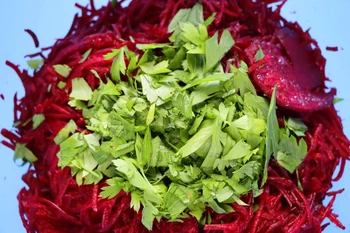
Whenever you have fresh herbs - parsley, chervil, coriander, mint, etc. - to incorporate into a recipe, we tell you to chop them up.
In this case, "chopping" means separating the leaves from the stems, keeping only the leaves, and chopping them more or less finely.
It's not very complicated, of course, but let's take a look at a few ways of doing it, and how to avoid certain pitfalls.
In this case, "chopping" means separating the leaves from the stems, keeping only the leaves, and chopping them more or less finely.
It's not very complicated, of course, but let's take a look at a few ways of doing it, and how to avoid certain pitfalls.
13 K 5/5 (3 reviews)
Keywords for this post:TipsTricksHow toHerbChopCutMinceParsleyLast modified on: September 12th 2023
How easy is it to chop herbs?
Preparation
In most cases, as mentioned above, the first step is to separate the leaves from the stems, keeping only the leaves, the most tender and fragrant part of the herb.This is done because, as a general rule, the stems are always a little hard, and not very pleasant raw. But you don't necessarily have to throw them away: parsley stems, for example, are wonderful for cooking in a sauce or dish, even if you have to remove them after cooking.


Let's chop!
Basically, just place the leaves on a chopping board, then chop them more or less finely, with a chopper or a knife, and you're done?Well, it's not quite that simple. First of all, you have to get rid of a common misconception: "The finer the chop, the better the taste".
No, it's a culinary legend, because the finer you chop, the more the herbs oxidize and lose their flavour, and the more some of their flavour is lost on the utensils. Cooks have a phrase for this, they say "taste is on the board".
In any case, as a general rule, herbs age very badly once chopped, so whatever the method, you have to be quick.
So chop them, but don't overdo it, proceed quickly, and incorporate the herbs into your recipe as soon as they've been chopped. Don't let herbs that have already been chopped sit on a corner of your work surface, as they will quickly lose their taste.
How to chop
There are several ways to proceed, but here are 3:Classic method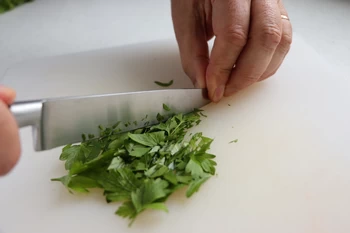
It's very simple, but you'll need to make quite a few strokes of the knife to chop all the herbs, which will need to be grouped together from time to time on the board.
The dumpling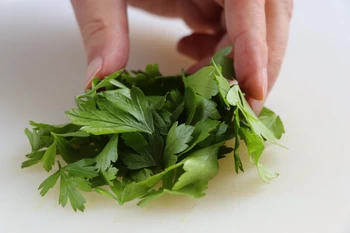
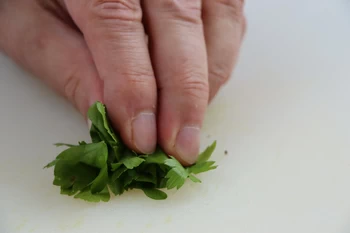
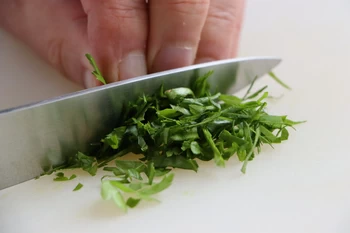
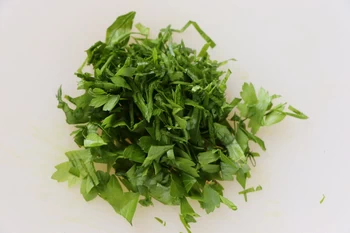
It's very efficient, and the herbs are chopped very quickly.
By the glass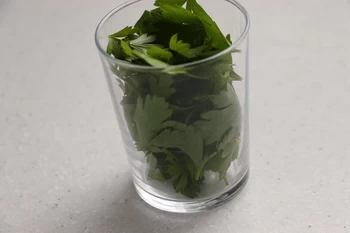

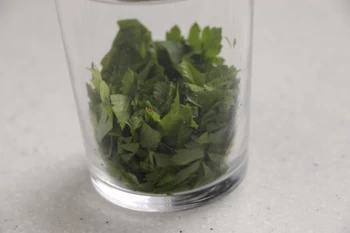
The herbs are placed in a glass, and a pair of scissors is used to cut directly into the glass, until the desired texture is obtained.
It's even quicker and more efficient, and all you have to do is pour the contents of the glass into the recipe. This is definitely my preferred method.
An electric chopper
As you may have noticed, all these methods are manual, so what about electric choppers?They're handy, of course, for chopping herbs and other things at the same time (garlic, onions, etc.), but they're admittedly not indispensable, and with them you tend to chop too finely, by pressing the button a little too long. If you use one, remember to chop for a few seconds at most.
To sum up: Chopping herbs is a simple matter, you just have to remember 1) not to chop too finely and 2) not to keep your chopped herbs waiting (incorporate them into your recipe as soon as they have been chopped).
Lasts posts
Butter vs. grease
We often read in a recipe where a pastry is put into a mould that, just before pouring, the mould should be buttered or greased. But what's the difference between these 2 terms?December 1st 20259015
Getting out of the fridge early
Very often when you're cooking, you need to take food or preparations out of the fridge, to use them in the recipe in progress. There's nothing tricky about this: you just take them out of the fridge and use them, usually immediately, in the recipe. But is this really a good method?November 24th 20251,0565
Who's making the croissants?
When you look at a bakery from the outside, you naturally think that in the bakery, the bakers make the bread, and in the laboratory, the pastry chefs make the cakes. It's very often like that, with each of these professions having quite different ways of working, but sometimes there's also one...November 23th 2025953
Oven height
When we put a dish or cake in the oven, we naturally tend to put it on the middle shelf, and that's what we usually do. But in some cases, this position and height can be a little tricky, so let's find out why.October 8th 20252,6205
The importance of sieving
In recipes that use a fine powder (flour, powdered sugar, etc.), you'll often see the advice to sift before using it. To sift is to pass the powder in question through a sieve (a very fine strainer) before incorporating it into your recipe. It's often advice, but is it really useful?September 3rd 20257,4573
Other pages you may also like
What is the difference between bakery and patisserie?
This is a question that you may well have asked yourself and which I will attempt to answer. In France the two trades of "boulangerie" (bakery) and "pâtisserie" (patisserie and confectionery) have always been quite distinct, but where exactly do the boundaries lie? .February 7th 2017134 K 14.1
The bitterness of endives
As I write these lines, we are entering the endive season, and if you like it, it's time to enjoy it, if possible with your local producers. Endive is good, but the reproach that is often made of it, and children in particular, is: "It's bitter! And it is (somewhat) true of course, endives...February 9th 201914 K4.9
The return of the "Norman hole"
You maybe know the "trou normand", this old gastronomic custom typically French which consists in taking a (small) glass of calvados, generally between the last course and the dessert? It's something that seems a bit anachronistic nowadays, having a glass of an alcohol of more than 60° in the...December 18th 202115 K4.8
Perpetual stock
It's something you have probably have done yourself: cooked or pre-cooked vegetables before adding them to a recipe. This is almost always done the same way: peel the chosen vegetables (carrots, for example), cut them up, boil them in salted water (using a tablespoon or so of coarse salt per litre),...November 22th 201631 K5
The skin side of the fish first?
When it comes to cooking fresh fish, if it's filleted with its skin on and you're planning to pan-fry it in a little olive oil, for example, you might ask yourself the following question: Which side, skin or flesh, should come into contact with the pan first?February 13th 202126 K4.4
Post a comment or question
Follow this page
If you are interested in this page, you can "follow" it, by entering your email address here. You will then receive a notification immediately each time the page is modified or a new comment is added. Please note that you will need to confirm this following.
Note: We'll never share your e-mail address with anyone else.
Alternatively: you can subscribe to the mailing list of cooling-ez.com , you will receive a e-mail for each new recipe published on the site.









